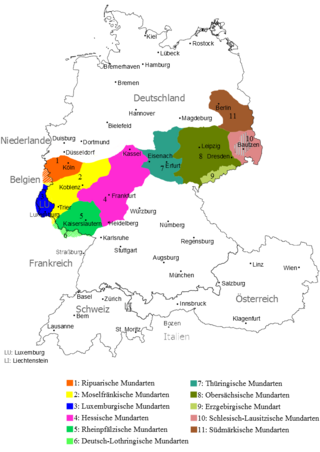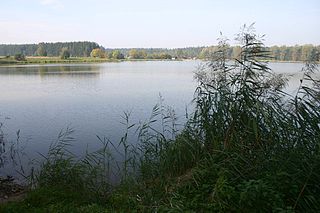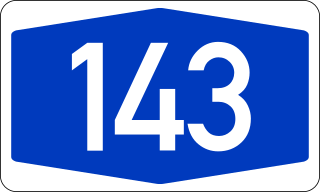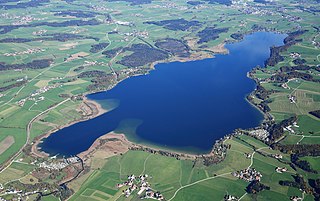
Lusatia is a historical region in Central Europe, split between Germany and Poland. Lusatia stretches from the Bóbr and Kwisa rivers in the east to the Pulsnitz and Black Elster rivers in the west, and is located within the German states of Saxony and Brandenburg as well as in the Polish voivodeships of Lower Silesia and Lubusz. Lusatia's central rivers are the Spree and the Lusatian Neisse, which constitutes the border between Germany and Poland since 1945. The Lusatian Mountains, separate Lusatia from Bohemia in the south. Lusatia is traditionally divided into Upper Lusatia and Lower Lusatia.

Central German or Middle German is a group of High German dialects spoken from the Rhineland in the west to the former eastern territories of Germany.
Central Germany is an economic and cultural region in Germany. Its exact borders depend on context, but it is often defined as being a region within the federal states of Saxony, Thuringia and Saxony-Anhalt, or a smaller part of this region, such as the metropolitan area of Leipzig and Halle plus the surrounding counties.

Taucha is a town in the district of Nordsachsen, in Saxony, Germany. It is situated on the river Parthe, 10 km northeast of Leipzig.

The Lusatian Lake District is a chain of artificial lakes under construction in Germany across the north-eastern part of Saxony and the southern part of Brandenburg. Through flooding as a part of an extensive regeneration programme, several decommissioned lignite opencast mines are in the process of being transformed into Europe's largest artificial lake district. However, the requirements of the project, especially the necessary water resources, are controversial.

Wassertrüdingen is a town in the district of Ansbach, Middle Franconia, Bavaria, Germany. It is between the Hesselberg, the only Franconian mountain with a view on the Alps, the wooded heights of the Oettinger Forest and the foothills of the Hahnenkamm. The Fränkisches Seenland recreation area is 15 kilometers away. Altentrüdingen, Fürnheim, Geilsheim, Obermögersheim, Reichenbach und Schobdach are part of Wassertrüdingen

The Mecklenburg Lake Plateau or Mecklenburg Lakeland is the largest coherent lake and canal region in Germany and is sometimes called "the land of a thousand lakes". There are several nature parks and well-known lakes with unique flora and fauna in the region, such as the Müritz, the biggest German lake lying entirely within Germany, the Plauer See, the Fleesensee, the Tollensesee, the Schmaler Luzin and the Kölpinsee.

Leipzig Hauptbahnhof is the central railway terminus in Leipzig, Germany, in the district Mitte. At 83,460 square metres (898,400 sq ft), it is Europe's largest railway station measured by floor area. It has 19 overground platforms housed in six iron train sheds, a multi-level concourse with towering stone arches, and a 298 metres (978 ft) long facade at the northeastern section of the Inner City Ring Road. The two Leipzig City Tunnel platforms were inaugurated in December 2013.

Zwochau is a village and a former municipality in the district (Landkreis) of North Saxony, in the administrative region (Direktionsbezirk) of Leipzig, in Saxony. Since 1 January 2013, it is part of the municipality Wiedemar.

The Kulkwitzer See, colloquially called Kulki, is a lake in the western part of Saxony, Germany. The lake is a part of the Central German Lake District.

RasenBallsport Leipzig e.V., commonly known as RB Leipzig, or simply Leipzig, is a German professional football club based in Leipzig, Saxony. The club was founded in 2009 by the initiative of the company Red Bull GmbH, which purchased the playing rights of fifth-tier side SSV Markranstädt with the intent of advancing the new club to the top-flight Bundesliga within eight years. The men's professional football club is run by the spin-off organization RasenBallsport Leipzig GmbH. RB Leipzig plays its home matches at the Red Bull Arena. The club nickname is Die Roten Bullen.

Dennenloher See is a lake in Ansbach, Bavaria, Germany. It has a surface area of 20 hectares. The lake is located 14 km west of Gunzenhausen, Dennenlohe. It is the smallest body of water in the Franconian Lake District.

The Middle German Chemical Triangle is the industrial conurbation around the cities and towns of Halle (Saale), Merseburg and Bitterfeld in the North German state of Saxony-Anhalt and Leipzig and Schkeuditz in the Free State of Saxony. Its name is derived from the dominant industries of the region – the chemical and oil refining industries.

Bundesautobahn 143 is an autobahn in Saxony-Anhalt, Germany. The A 143 comprises the western leg of the Mitteldeutsche Schleife, a beltway around the cities of Halle an der Saale and Leipzig. 9 km of the planned 22 km route have been completed, due to the autobahn's path potentially disturbing an environmentally sensitive area.

Großer Brombachsee is a reservoir in the Franconian Lake District in the south of central Franconia. It is fed and drained by the Brombach. Together with its two pre-dams, the Kleiner Brombachsee and the Igelsbachsee, it forms the region Brombachsee.

The Sternberg Lake District Nature Park lies in the lake regions of Warin-Neukloster, the Sternberg Lake District and the central Warnow valley in the districts of Ludwigslust-Parchim and Nordwestmecklenburg in the German state of Mecklenburg-Vorpommern. It lies east of Lake Schwerin in the region of Sternberg, Brüel, Güstrow, Bützow, Warin and Neukloster.

The Leipzig Bay(German: Leipziger Tieflandsbucht) or Leipzig Basin or Saxon Lowland or Saxon Bay is a relatively lakeless and highly fertile landscape in Central Germany, in northwestern Saxony and southeastern Saxony-Anhalt.

Der Wallersee is a lake in the Austrian state of Salzburg northeast of the city oft Salzburg in Salzburg-Umgebung District.

The Cospudener See is an artificially constructed lake situated directly on the southern outskirts of Leipzig, Germany. Leipzig, Markkleeberg and Zwenkau have shares in the lake which is on the site of a former open cast mine. The lake is popularly known as "Cossi", more rarely "Cospi", and has become highly popular with the local population, with long stretches of sand beaches and with a sauna directly located at the lake. There is also a small sailing harbor. The lake is a part of the Central German Lake District.

















